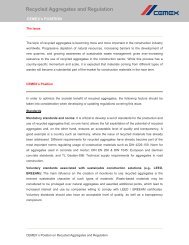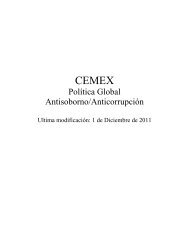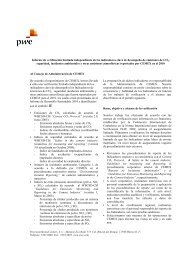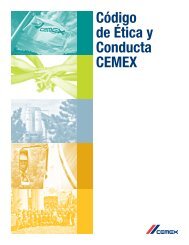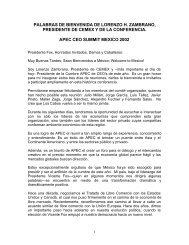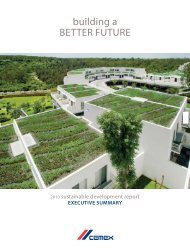building a STRONGER foundation - Cemex
building a STRONGER foundation - Cemex
building a STRONGER foundation - Cemex
Create successful ePaper yourself
Turn your PDF publications into a flip-book with our unique Google optimized e-Paper software.
On April 12, 2011, we obtained consents from the required lenders and our major creditors under the Financing Agreement to<br />
make certain amendments to the Financing Agreement to allow us to retain funds in the CB reserve from disposal proceeds, permitted<br />
fundraisings and cash in hand, to meet CBs maturing in April and September 2012.<br />
We refer to the prepayments of CBs in January and March 2011, the prepayments to the Financing Agreement in February,<br />
March and April 2011, and additional repayments of indebtedness of approximately U.S.$59 million, collectively, as the 2011<br />
Prepayments. For a more detailed description of the transactions completed after December 31, 2010, see “Item 5 — Operating and<br />
Financial Review and Prospects — Recent Developments — Recent Developments Relating to Our Indebtedness.”<br />
As of December 31, 2010, after giving pro forma effect to (1) the issuance of the January 2011 Notes, the 2011 Optional<br />
Convertible Subordinated Notes and the April 2011 Notes, (2) the 2011 Prepayments and (3) the 2011 Private Exchange, our total debt<br />
was approximately Ps208,100 million (U.S.$16,837 million), not including approximately Ps14,342 million (U.S.$1,160 million) of<br />
Perpetual Debentures, but including our debt not subject to the Financing Agreement, which was approximately Ps115,829 million<br />
(U.S.$9,372 million). Of such pro forma total debt amount, approximately Ps1,059 million (U.S.$86 million) matures during 2011;<br />
Ps4,717 million (U.S.$382 million) matures during 2012; Ps9,283 million (U.S.$751 million) matures during 2013; Ps99,956 million<br />
(U.S.$8,087 million) matures during 2014; and Ps93,085 million (U.S.$7,531 million) matures after 2014.<br />
As of December 31, 2010, after giving pro forma effect to (1) the issuance of the January 2011 Notes, the 2011 Optional<br />
Convertible Subordinated Notes and the April 2011 Notes, and (2) the 2011 Prepayments, the Financing Agreement had the following<br />
semi-annual amortization schedule, with a final maturity of approximately U.S.$6.8 billion on February 14, 2014:<br />
* Repaid in full.<br />
Repayment Date<br />
4<br />
Cumulative<br />
repayment<br />
amount %<br />
Original<br />
repayment<br />
amount %<br />
Approximate required<br />
payment<br />
(in millions of Dollars)<br />
June 2011*................................................................... 20.69% 1.59% —<br />
December 2011*.......................................................... 33.11% 12.42% —<br />
June 2012*................................................................... 35.75% 2.64% —<br />
December 2012*.......................................................... 38.39% 2.64% —<br />
June 2013*................................................................... 46.35% 7.96% —<br />
December 2013............................................................ 54.31% 7.96% U.S.$ 696<br />
February 2014.............................................................. 100.00% 45.69% U.S.$ 6,769<br />
The pro forma financial information giving effect to our most significant transactions completed after December 31, 2010 has<br />
been included in this annual report for the convenience of the reader.<br />
Risk Factors<br />
Many factors could have an effect on our financial condition, cash flows and results of operations. We are subject to various<br />
risks resulting from changing economic, environmental, political, industry, business, financial and climate conditions. The factors we<br />
consider most important are described below.<br />
Economic conditions in some of the countries where we operate may adversely affect our business, financial condition and<br />
results of operations.<br />
The economic conditions in some of the countries where we operate have had and may continue to have a material adverse<br />
impact on our business, financial condition and results of operations throughout our operations worldwide. Our results of operations<br />
are highly dependent on the results of our operating subsidiaries in the U.S., Mexico and Western Europe. Despite some aggressive<br />
measures taken by governments and central banks thus far, there is still a significant risk that these measures may not prevent several<br />
of the countries where we operate from falling into an even deeper and longer lasting recession. In the construction sector, declines in<br />
residential construction in several of our major markets have broadened and intensified in line with the spread and deterioration of the<br />
financial crisis. The adjustment process has been more severe in countries that experienced the largest housing market expansion<br />
during the years of high credit availability (such as the U.S., Spain, Ireland and the U.K.). Most government sponsored recovery<br />
efforts focus on fostering growth in demand from infrastructure projects. The infrastructure plans announced to date by many<br />
countries, including the U.S., Mexico and Spain, may not stimulate economic growth or yield the expected results because of delays in<br />
implementation and/or bureaucratic issues, among other obstacles. A worsening of the economic crisis or delays in implementing any<br />
such plans could adversely affect demand for our products.



